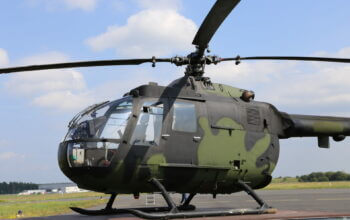Estimated reading time 6 minutes, 19 seconds.
A new white paper from the Canadian Advanced Air Mobility Consortium (CAAM) makes the case that the Greater Toronto Area has what it takes to be an early adopter of advanced air mobility (AAM), including electric vertical take-off and landing (eVTOL) aircraft.
Prepared by Nexa Advisors, a financial and economic advisory company in Washington, D.C., CAAM’s white paper suggests Toronto’s strong economy, extreme road congestion, ambitious decarbonization goals, thriving technology sector, and flourishing aerospace industry are some of the key factors that could make Toronto an early adopter of AAM.

“We are very excited about the prospects for the Greater Toronto Area,” said Michael Dyment, founder and managing partner of Nexa Advisors. “There are other markets in the United States and Canada that are also looking at advanced air mobility, and there’s room for viability and very generous economic benefits for all.”
Because of Toronto’s world-class medical facilities, it is likely the city will first deploy AAM in the medical field, transporting critically ill patients, vaccines, personal protective equipment, and organs at a fraction of the cost and noise of helicopters, the white paper suggests. Just last month, the city became a leader in this regard when United Therapeutics subsidiary Unither Bioelectronics used a drone to transport donor lungs for transplant between two Toronto hospitals — a world first.
Authors of the white paper believe that in the next few years, quiet, lightweight, zero-emission eVTOLs will transform mobility in Toronto for commuters and cargo. Thanks to their relatively low operating and maintenance costs, they could offer a revolutionary form of mobility in metropolitan areas, integrating with the existing transportation system and helping reduce congestion.
Passengers will be able to book quick flights on their phone and have piloted air taxis arrive at pickup locations that are integrated with other transportation modes, such as airports and train stations, the white paper predicts.
Meanwhile, regional air mobility using electric short take-off and landing (eSTOL) and other AAM aircraft will help bring cities closer by providing short flights from Toronto to nearby cities that would otherwise be time-consuming to reach by car.
However, in order for AAM to take off in Toronto, there is still a great deal of work that needs to be done, according to the white paper.
“Aircraft developers must finalize their designs, and aviation authorities must build on existing regulations that have safeguarded air safety to create new airworthiness and operational certifications and regulations,” the white paper states.
Critical infrastructure, such as take-off and landing facilities and air traffic control systems, needs to be ready to support urban operations. Air traffic flow also needs to be mapped out.
CAAM’s white paper argues that if Toronto is proactive in meeting these challenges, it can reap the rewards of “early adopter advantages,” including investment dollars, top aerospace talent, and timely orders for popular aircraft. Investment to fund the infrastructure will likely come from public-private partnerships (PPPs), which are long-term contracts between a private investor and a government entity for providing a public service.
In addition to the white paper, CAAM has retained Nexa Advisors to prepare an economic impact analysis to determine the number of full-time permanent jobs, tax revenues, and overall economic activity that AAM and eVTOL aircraft could bring to Toronto.
Based on similar studies, including one it conducted for Vancouver, CAAM predicts that Toronto may see thousands of new jobs, hundreds of millions in new tax revenues, and billions in new overall economic activity from now to 2045.
While the Toronto economic impact analysis won’t be released until November 2021, Dyment is confident about eVTOL’s economic impact on the city.
“In terms of operating revenues, there’s a US$10.7 billion, 25-year forecast that we stand behind,” said Dyment, who believes the significant figure could help encourage investment, as well as fund infrastructure.








